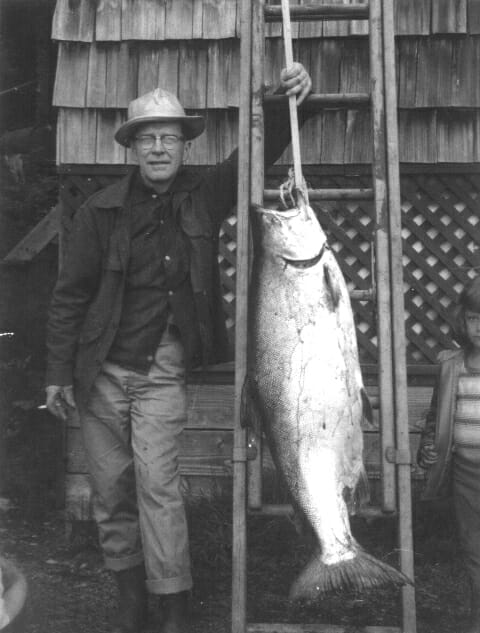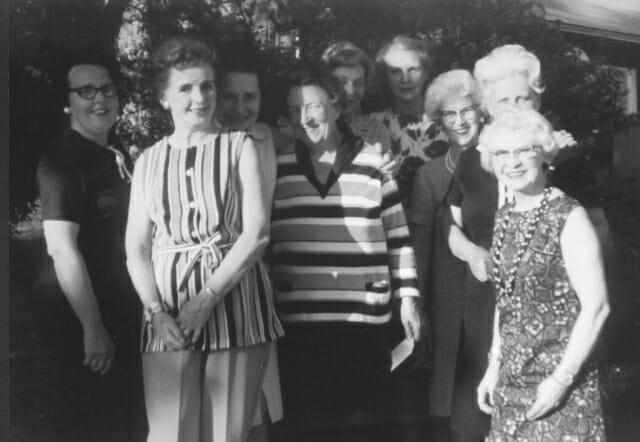Gastineau Channel Memories
Wyller/Berlin/Abrahamsen
Elizabeth (Wyller) Evans
Christian Frederik Wyller was born in Stavanger, Norway, on July 25, 1901. He grew up there, as a young man served in the King?s Guard for 18 months, and was educated at the University in Trondheim as a civil engineer, specializing in structures. In 1924, he emigrated to the United States as a start to seeing the world, living first in Brooklyn for six months where he worked for a private engineering firm. City life did not appeal to him however, so in 1925, he and several Norwegian friends bought a car and drove across country to Seattle. There they sold the car, bought a troller and set off for Alaska.
They arrived in Petersburg in late summer and were greeted with open arms-the community was strongly Norwegian. Norwegian was commonly spoken in town even by Tlingits and any Norwegian newcomer was heartily welcomed. Chris and his friends were told of two abandoned cabins on nearby Kupreanof Island and encouraged to make use of them. So they settled in and lived off the land for the winter. Fish and game were abundant and Chris truly thought he had found God?s Country. For the rest of his life he retained a deep fondness for the Petersburg area and the many good friends he made there.
The next spring he moved to Juneau and began a 35-year career with the Bureau of Public Roads, building and maintaining roads and bridges in many parts of the territory, including the original Douglas Bridge and sections of Glacier Highway. Like other engineers, he spent summers in the field and winters in town.
At the same time Chris and his friends were enroute to Petersburg, his future wife Mildred Abrahamsen was traveling by steamer to Juneau to take a teaching job. (In later years they speculated that they first saw each other on the Inside Passage and possibly even waved.) Mildred was born in Kindred, North Dakota, on November 1, 1900. She began teaching directly out of high school and in 1925, planned to work in Alaska for two years, then go Hawaii, then to Australia, etc. Of course she didn?t get beyond Juneau. She and Chris met as part of a very lively singles group at the time in Juneau. Female teachers were required to be single (this didn?t change until there was a shortage of teachers during World War II), and most of them lived in the Gastineau Hotel downtown. They led very active social lives with weekly formal dances at the Elks Hall and frequent parties, outings, etc.
The physical area of Juneau was quite small in the 20?s. Though there was a road and some houses north of town, as well as south at Thane, few people had cars and most activities took place downtown. In later years, Mildred mentioned having gone ?out to Stewart?s? to play bridge with Judge Tom Stewart?s mother. When asked whether Stewart?s lived out the road then, she said that Calhoun, site of the Stewart house WAS out the road.
In 1928, Mildred?s younger sister Margaret (Peg) arrived to join the teachers at the Gastineau Hotel. They both taught at the old Fifth Street School, which was then the public grade school. Mildred resigned upon her marriage but returned to teaching stints during and after World War II. Margaret also taught in Douglas, Tanana, Anchorage, Fairbanks and at the end of her career, Auke Bay; she retired in 1971. Neither of them had college degrees when they began teaching; by attending summer school for years, Mildred achieved about two years of college, but Margaret eventually got her degree in 1948 from Western Washington State College.
Two younger brothers Raymond and Erling Abrahamsen followed their sisters to Juneau in 1929. Both initially worked for the AJ Mine but in 1930, Ray moved to the U.S. Post Office where he stayed for 38 years. Erling returned to North Dakota in the early 40?s, married and raised a family there.
Chris and Mildred were married on June 13, 1931, in the home of the Norwegian Consul, William Britt, on 7th Street. Their son, also Christian Frederik, was born July 17, 1932, and their daughter Elizabeth on October 30, 1935. In 1936, they bought a house at 6th and Gold, the site of the city water supply in earlier years, and lived there until retirement.
In 1938, Chris was increasingly concerned about the threat of war in Europe. He hadn?t seen his three brothers and four sisters for fourteen years and two of his brothers in Oslo were actively warning against Hitler via newspaper and magazine articles. He decided to borrow money to take his family back to visit Norway, a five-month trip that involved going by steamer to Seattle, across the country by train and two weeks across the Atlantic by freighter. It was a trip he never regretted since the Nazis occupied Norway the next year and he heard nothing of his family until after the German surrender in 1945. Several did not survive the war and a number of those who did spent it in concentration camps.
Immediately after Pearl Harbor, there was fear of the Japanese bombing Juneau but eventually life during the war years became relatively calm. Chris tried to enlist in the SeaBees but was told he was needed more as an engineer in Alaska. Ray also was turned down for the Army. Margaret in the early 40?s, married Leonard ?Whitey? Berlin, an engineer who had traveled to the Antarctic on one of the Byrd expeditions; then in the Navy, he later worked for the BLM. (They divorced in the early 50?s.)
When contact with Chris? family was re-established after the war and Chris and Mildred learned how devastated Norway was, as well as the rest of Europe, they set about sending what they could to help, beginning with sugar, coffee, tea, chocolate, etc.-things no one there had seen in years. Government restrictions on the size and weight of packages were rigid; one ounce too heavy or an inch too big would mean it would be returned, so weighing and wrapping were a frustrating and often late-night job which not infrequently invoked profanity on the part of Chris.
They also sent clothing and eventually Mildred became part of a Red Cross clothing effort on a larger scale. Juneauites donated used clothes, the dry cleaners cleaned them for free and Mildred coordinated getting them shipped. For years her house resembled a big rummage sale. She also coordinated a program which provided yarn and patterns for sweaters and precut snowsuits for local women to knit and sew. In 1946, three of Chris? relatives were expecting babies so Mildred gave several huge baby showers for new and used baby things. The response was overwhelming and provided enough clothing for dozens of babies for years to come. The recipients of all this were extremely grateful and several years later King Haakon of Norway sent Mildred a pewter plate, officially thanking her for all her work.
A few months after Pearl Harbor, the Wyllers bought a small cabin on Fritz Cove Road where they lived every summer until the mid-60?s, when they retired there. It originally had no running water nor electricity and there were open knotholes in the shiplap walls but they both loved it. Mildred washed clothes by hand and ironed with flatirons and was happy not to go to town all summer, while Chris, who loved working on carpentry projects did everything over the years from rebuilding the cabin and its fireplace to making furniture to designing and building a rowboat. During their first two summers there they did not own a car and Chris hitchhiked to town every day to work. He never had a problem getting a ride.
He also loved hunting and fishing-his children grew up on a diet of venison and canned fish and wouldn?t have traded it. During his early years in Juneau, he and Mark Jensen became good friends and hunting buddies; their annual hunting trips together to Chichagof Island continued until shortly before Chris died in 1978. They never tired of telling stories about these trips; this appeared to be at least as much fun as going on them!
Mildred and Margaret were avid bridge players from the time they came to Juneau and played every chance they got. For years they both belonged to a bridge club, as well as a book club, PEO and Eastern Star. Margaret was also a life member of the National Education Association. They, as well as Chris and Ray, belonged to the Pioneers, Sons of Norway and the Resurrection Lutheran Church. Chris also was a Mason and a member of the American Society of Civil Engineers and the National Society of Professional Engineers and served on the Juneau Planning Commission. Ray also belonged to the National Association of Retired Federal Employees and was a life member of the Juneau Elks Club.
During the 60?s, Chris retired from the Bureau of Public Roads and set up a private engineering firm which designed the Ketchikan Airport among other Alaskan projects. He and Mildred turned their Fritz Cove cabin into a year-round home and moved there. Margaret and Ray combined households and moved to another winterized cabin she owned near the Wyllers. The Wyllers traveled to Norway every few years after retirement and Margaret took trips all over the world, while Ray stayed closer to home and continued to be favorite uncle to the Wyller children and grandchildren as well as numerous friends? children.
Chris died in 1978, Mildred in 1986, Ray in 1991, and Margaret in 1992.
Chris and Mildred?s son Fred, graduated from Juneau High School in 1951, attended Reed College in Portland for three years, and graduated in 1959, from the Colorado School of Mines as a geological engineer. He worked in Texas for some years before returning to Alaska to take a job with the Highway Department. In 1968, while employed by the Numont Mining Co., he was seriously injured in a helicopter crash near Ketchikan. Consequently, unable to work in the field he became active in business, owning a marine fuel dock for several years and various real estate in the Juneau area. He also built and lived for years on the Fair Lady, a 48-foot vessel on which his relatives had many wonderful trips. He now lives in the Fritz Cove house formerly owned by his parents.
Elizabeth Wyller graduated from Juneau High School in 1953, and earned a B.A. and M.A. in Music in 1958 and 1959, respectively, from Stanford University. She married Gordon Evans in 1964; they have two children-Erik born on December 6, 1965, and Kari born on March 9, 1974. She worked for the state government for some years, her most interesting job being for Secretary of State Hugh Wade during the first eight years after statehood. In the 1970?s, she began teaching music, first privately, and then on the UAS faculty. From the early 60?s until the 90?s, she was active on the boards of various musical organizations such as the Juneau Concert Association, Juneau Symphony, Juneau Jazz and Classics and the local Arts Council and also performed occasionally on the piano and organ. Now retired, she and her husband Gordon, a retired attorney and lobbyist, still live in the old Wyller house at 6th and Gold.
 |
|
 |
|
 |
|
